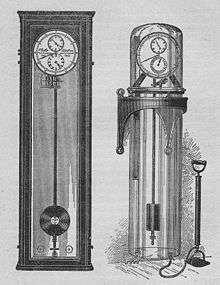Sigmund Riefler
Sigmund Riefler (August 9, 1847 – October 21, 1912) was a German physicist, inventor and precision clockmaker.[1][2]
Sigmund Riefler | |
|---|---|
 | |
| Born | August 9, 1847 Maria Rain |
| Died | October 21, 1912 (aged 65) Munich |
| Alma mater | University of Munich |
| Known for | Riefler escapement |
| Scientific career | |
| Fields | Horology |
Life
Sigmund Riefler was born on August 9, 1847 to Magdalena and Clemens Riefler. He studied mathematics, geodesy and mechanical engineering at the Technical University of Munich, and then physics and astronomy at the University of Munich. From 1870 he worked as an engineer in the Royal Prussian Land Survey, surveying land in Schleswig.[3]
In 1876 after the death of his father, he took over the firm of Clemens Riefler with his two brothers, Adolf and Theodor. Sigmund worked mainly on new developments in the area of drawing instruments and precision clocks, while his brothers handled the technical, sales and management of the company.
In 1878 he settled in Munich, to be in contact with the local scientific community.[4] He invented the Riefler escapement which was patented in 1889.[5] He died in Munich on October 21, 1912 at the age of 65.

In popular culture
Monroe mentions Sigmund Riefler in the "One Night Stand" episode in Season 3 of Grimm.
Awards
- 1894 John Scott Medal of the Franklin Institute in Philadelphia, USA[6]
- 1897 Honorary Doctorate (Dr. phil. hc) of the Philosophischen Fakultät der Universität München[6]
- 1899 Sigmund and both brothers received the honorary citizenship of the market town Nesselwang (new site since 1879 the company)
- 1900 Golden Delbrück-Denkmünze of the Verein zur Förderung des Gewerbefleißes in Prussia[6]
- 1905 Kommerzienrat Title
Patents
- 1889 DRP Nr. 50739 Doppelradhemmung für Chronometer mit vollkommen freier Unruhe und für Pendeluhren mit freiem Pendel.
- 1891 DRP Nr. 60059 Quecksilber-Kompensationspendel.
- 1893 US Patent 508530 Mercurial Compensation-Pendulum
- 1893 US Patent 508760 Pendulum-Escapement
- 1897 DRP Nr. 100870 Pendel mit Nickelstahlstange und mehreren zusammenwirkenden Compensationsröhren.
- 1903 DRP Nr. 151710 Elektrische Aufziehvorrichtung für Uhren mit einem treibenden Gewichtshebel und einem Elektromagneten zum Heben desselben.
- 1913 DRP Nr. 272119 Schwerkrafthemmung mit zwei Antriebshebeln.
References
- Riefler, Dieter: Riefler-Präzisionsuhren: 1890-1965; Callwey Verlag; München 1991; ISBN 3-7667-1003-6
- Dr. Sigmund Riefler; by C. Dietzschold; Der Cornelius Nepos der Uhrmacher; Krems 1910; S.57.
- Precision Pendulum Clocks: France, Germany, America, and Recent Advances; by Derek Roberts; 2004; ISBN 0-7643-2021-1
- Erbrich, Klaus: Präzisionspendeluhren: von Graham bis Riefler; Callwey Verlag; München 1978; ISBN 3-7667-0429-X
- Precision Pendulum Clocks: The Quest for Accurate Timekeeping; by Derek Roberts; 2003; ISBN 0-7643-1636-2
- Day, Lance; Ian McNeil (1996). Biographical Dictionary of the History of Technology. New York: Routledge. ISBN 9780203028292. p.602
External links
| Wikimedia Commons has media related to Sigmund Riefler. |
| German Wikisource has original text related to this article: |
- Special catalogue of the collective exhibition of scientific instruments and appliances exhibited by the Deutsche gesellschaft für mechanik und optik, Berlin
- Uhrenkabinett der Staatlichen Museen Kassel: precision clock in pressure-tight tank
- Ladd Observatory: Riefler Precision Clock
- Riefler Industry GmbH & Co. KG History of company from official website